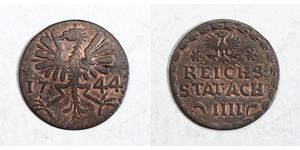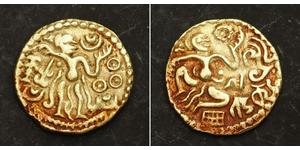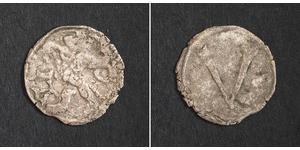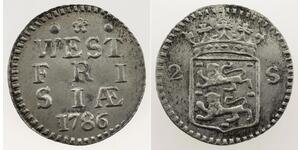(Verkauft für $307.0)
Kushan Empire, Kidara (posthumous issue, 385-450 AD) Gold Stater Coin. 7.99gm!
Mint Place: Taxila
Denomination: Gold Stater
Reference: MK 615, Göbl D.B. 1582 ff. R!
Mint Period: 385-450 AD (posthumous in the name of Kidara!)
Condition: A typical crude, double-struck specimen, issued in average gold purity, otherwise XF!
Material: Gold (average purity)
Diameter: 23mm
Weight: 7.99gm
Obverse: King Kidara standing facing, head left, sacrificing over altar t left and holding standard. Filleted trident in left field.
Reverse: Goddess (Ardoksho) enthroned facing, holding cornucopiae in left hand.
Authenticity on all offered coins guaranteed.
The Kushan Empire originally formed in the 1st century AD in the territories of ancient Bactria on either side of the middle course of the Oxus River or Amu Darya in what is now northern Afghanistan, and southern Tajikistan and Uzbekistan.
During the 1st and early 2nd centuries AD the Kushans expanded rapidly across the northern part of the Indian subcontinent at least as far as Saketa and Sarnath near Varanasi (Benares) where inscriptions have been found dated to the first few years of era of the most famous Kushan ruler, Kanishka which apparently began about 127 AD.
The Kushan kings were a branch of the Yuezhi confederation (possibly intermarried with local families) and they had diplomatic contacts with Rome, Persia and Han China. While much philosophy, art, and science was created within its borders, the only textual record we have of the empire's history today comes from inscriptions and accounts in other languages, particularly Chinese. The empire declined from 3rd century and fell to the Sassanid empire and Gupta Empire.

|
Beigetragen von:
anonymous 2014-05-22 |

8 Maravedi Kingdom of Spain (1814 - 1873 ...
Diese Gruppe hat 6 Münzen / 6 Preise
Add coin to this group

1 Tetradrachm Römische Kaiserzeit (27BC- ...
Diese Gruppe hat 2 Münzen / 1 Preise
Add coin to this group

1 Denga Russisches Reich (1720-1917) Kup ...
Diese Gruppe hat 7 Münzen / 7 Preise
Add coin to this group

1 Paisa Britische Ostindien-Kompanie (17 ...
Diese Gruppe hat 5 Münzen / 4 Preise
Add coin to this group

4 Heller Reichsstadt Aachen (1306 - 1801 ...
Diese Gruppe hat 5 Münzen / 4 Preise
Add coin to this group
2 Stuiver Niederlande Silber
Diese Gruppe hat 33 Münzen / 33 Preise
⇑
10 Cent Königreich der Niederlande (1815 - ) Silber
Diese Gruppe hat 2 Münzen / 2 Preise
⇑












-300-150-qBfBwcI0rVkAAAEqjVtDRaZv.jpg)






